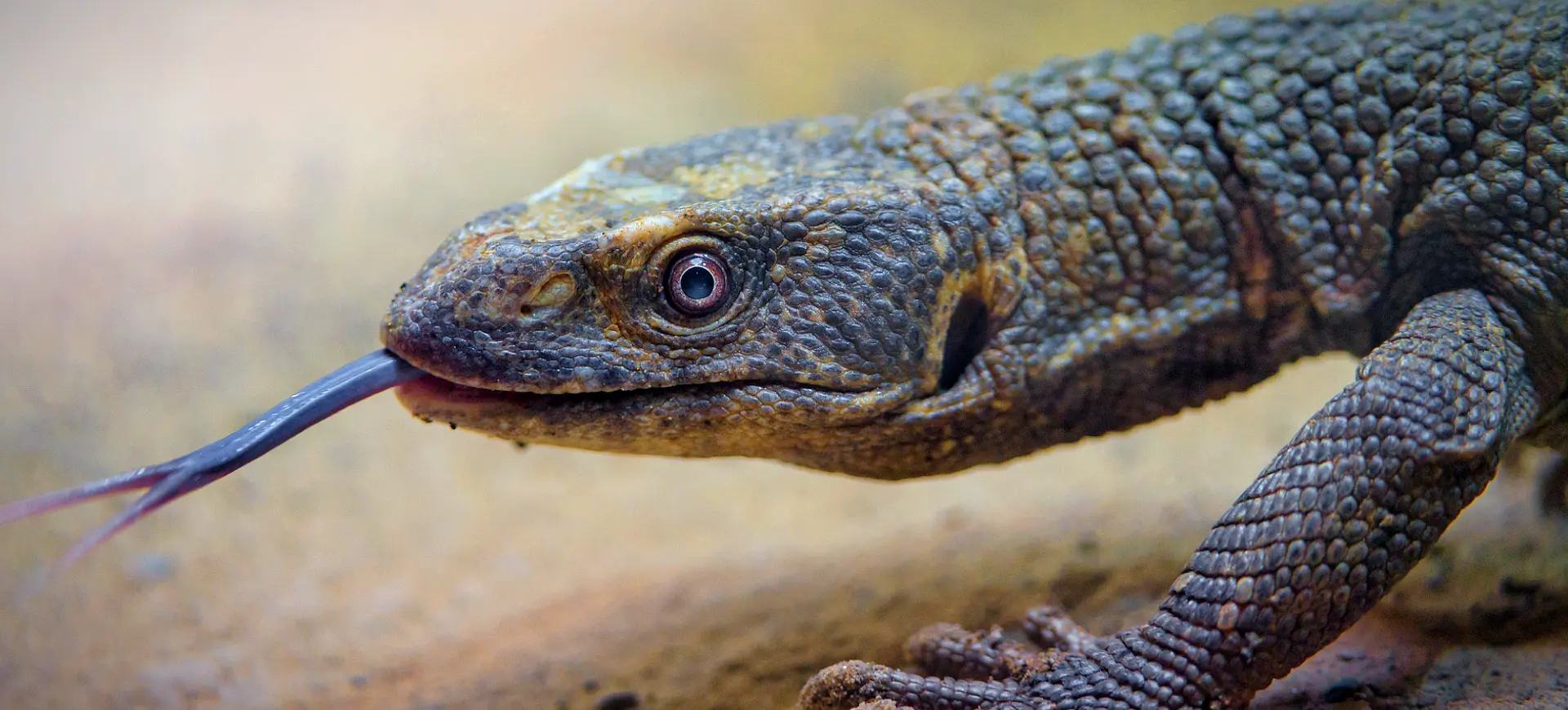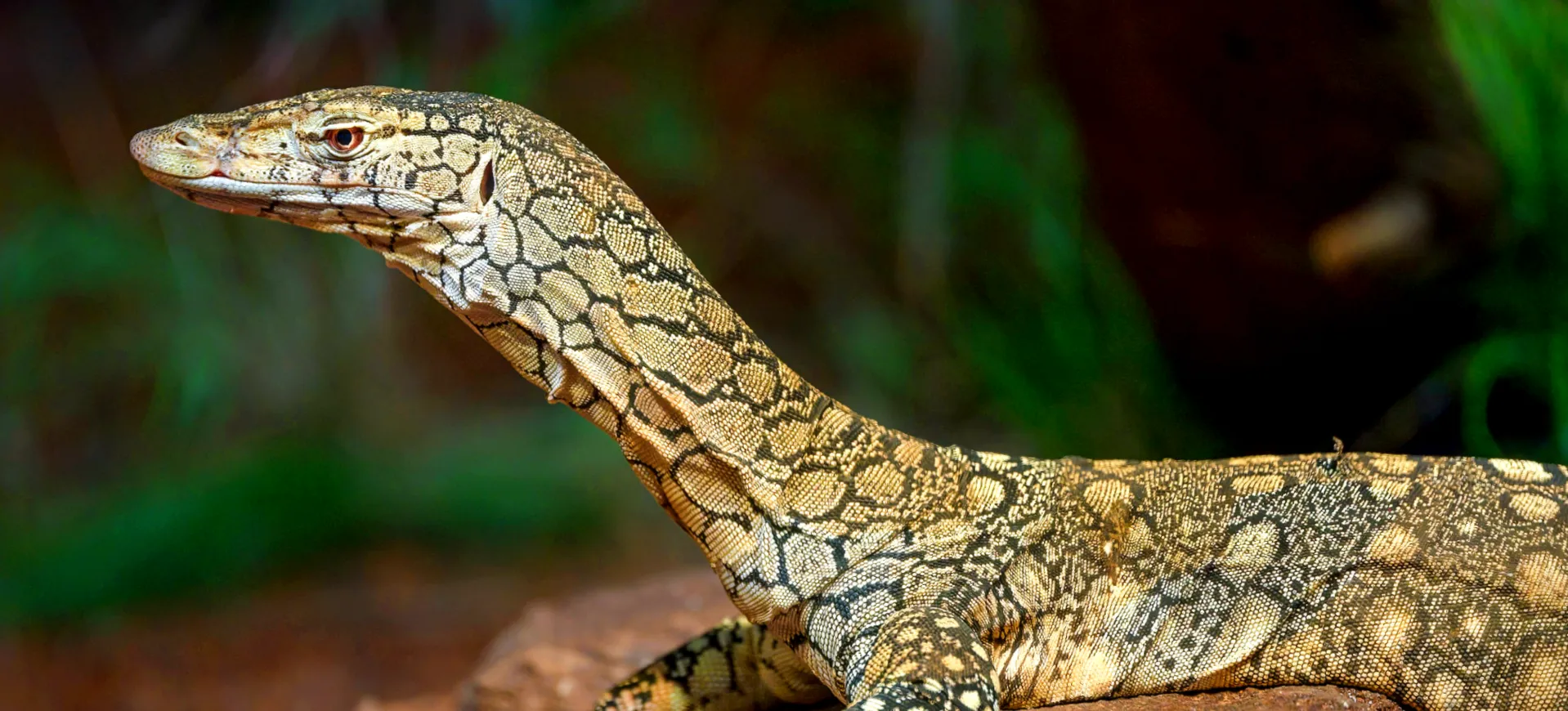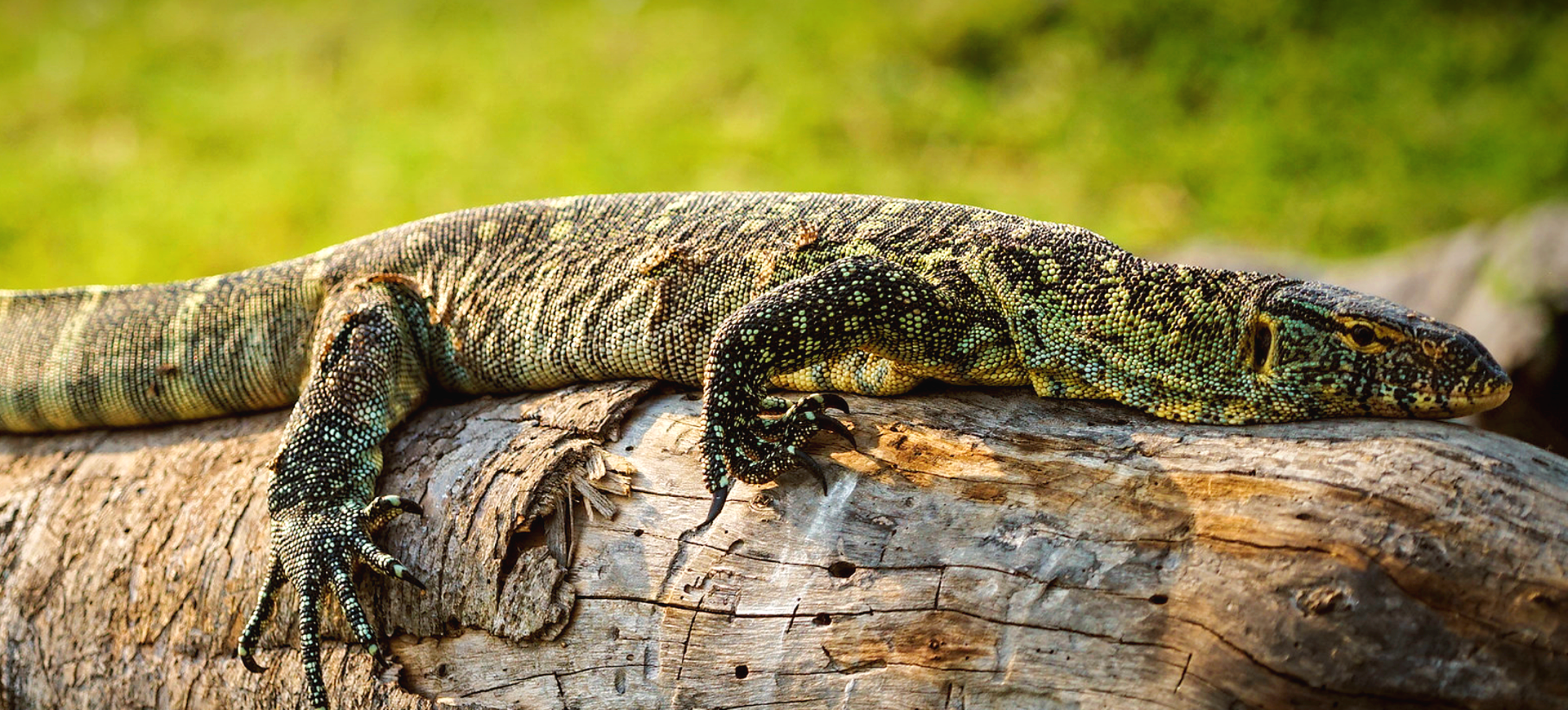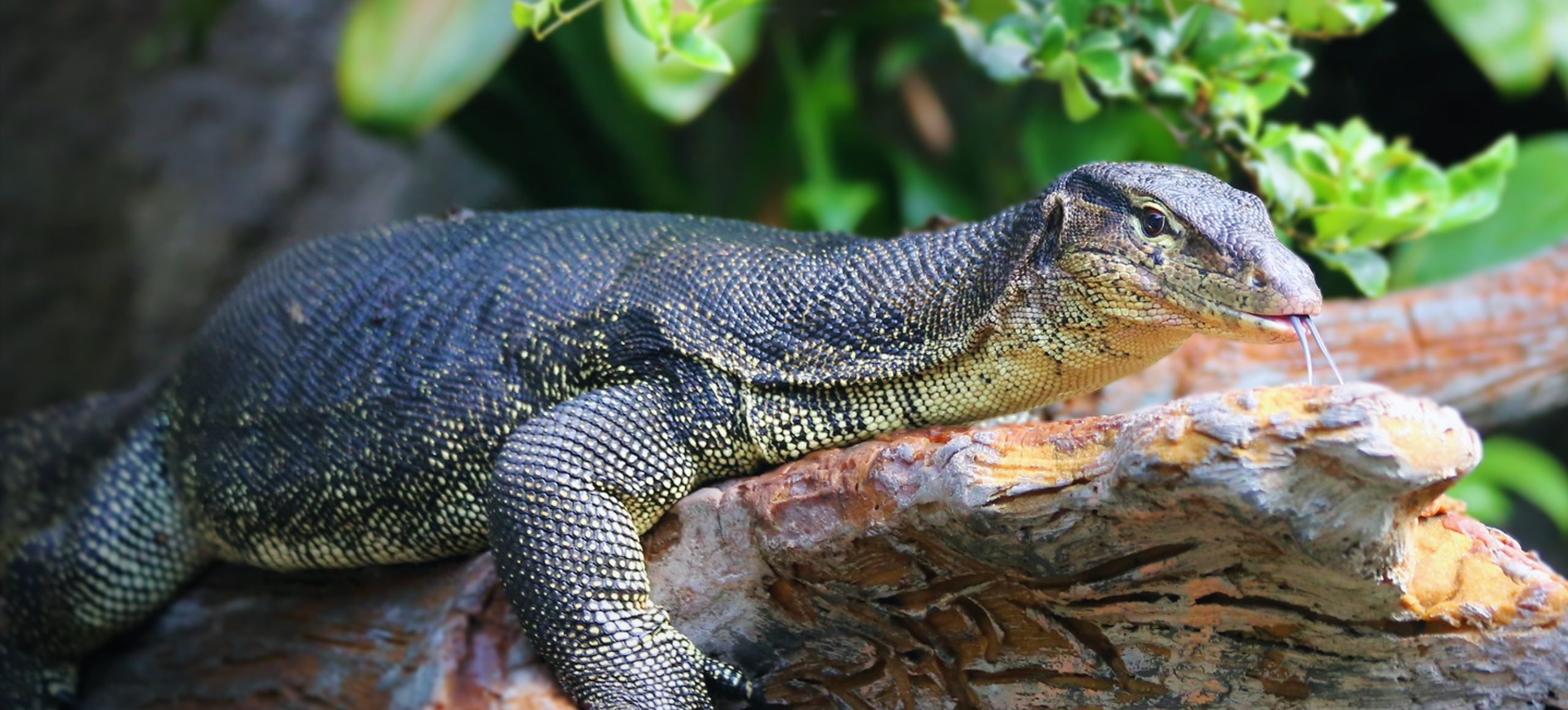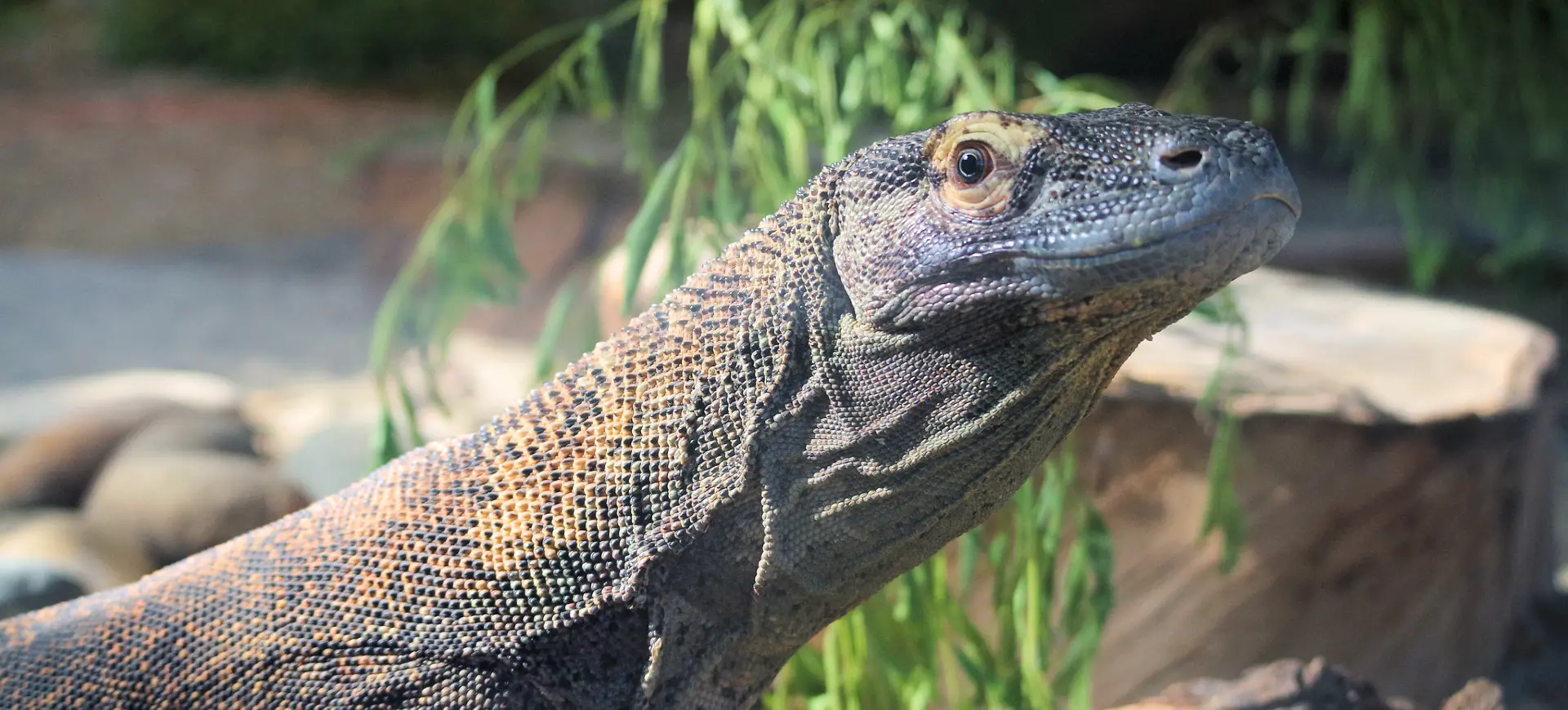Overview
The Crocodile Monitor, scientifically known as Varanus Salvador, is one of the longest lizards in the world, native to Papua New Guinea. It is renowned for its impressive size, with some individuals reaching lengths of up to 8 feet (2.44 meters), though the majority are smaller. This species is characterized by its elongated head and neck, a strongly compressed tail, and powerful limbs equipped with sharp claws. Its skin is dark green to black, with bright yellow and green spots and bands, providing excellent camouflage in its rainforest habitat.
The Crocodile Monitor inhabits tropical rainforests, spending much of its time in trees. Its arboreal lifestyle is supported by its prehensile tail and sharp claws, which aid in climbing. The diet of the Crocodile Monitor primarily consists of small mammals, birds, eggs, and carrion, making it an opportunistic predator. This monitor lizard is known for its wariness and elusive nature, often avoiding human contact.
Despite its size, the Crocodile Monitor is a relatively unknown species, with much of its behavior and ecology remaining a mystery. It is considered one of the most aggressive Varanid lizards, known for its powerful bite and tendency to lash with its tail when threatened. The conservation status of the Crocodile Monitor is not well-documented, but habitat destruction and hunting for its skin and meat pose significant threats to its population.
Physical Description:
The Crocodile Monitor is distinguished by its large size and distinctive physical features. The lizard possesses a slender body, an elongated head, and a long, prehensile tail, which can be twice the length of its body. The tail is used for balance and support in their arboreal habitat. The skin of the Crocodile Monitor is tough and scaly, protecting predators and environmental elements.
Adult Crocodile Monitors typically measure between 6 to 8 feet (1.8 to 2.44 meters) in length, with a significant portion attributed to their tail. They exhibit a coloration of dark green to black with bright yellow or green spots and bands, which serve as excellent camouflage in the rainforest canopy. The limbs are strong and muscular, equipped with sharp claws, essential for climbing and capturing prey. The overall appearance of the Crocodile Monitor is both formidable and well-adapted to its environment.

Lifespan: Wild: ~10 years || Captivity: ~20 years

Weight: Male: 33-44 lbs (15-20 kg) || Female: 33-44 lbs (15-20 kg)

Length: Male: 96-144 inches (244-366 cm) || Female: 96-144 inches (244-366 cm)

Top Speed: Up to 10 mph (16 km/h)
Characteristic:
Native Habitat:
The Crocodile Monitor is native to the tropical rainforests of Papua New Guinea. This species prefers dense, humid forest environments where it can utilize its climbing abilities. The Crocodile Monitor is often found near rivers and streams within the forest. The arboreal nature of this lizard means it spends much of its time in trees, using its prehensile tail for balance and maneuverability.
The habitat of the Crocodile Monitor is crucial for its survival, providing both food sources and protection from predators. The dense foliage of the rainforest offers ideal conditions for hunting and concealment. The conservation of their natural habitat is important for the species’ survival, particularly as rainforest areas face increasing threats from logging and development.
Climate Zones:
Biomes:
WWF Biomes:
Biogeographical Realms:
Countries:
Diet:
Diet & Feeding Habits:
The Crocodile Monitor is a carnivorous predator with a diet of small mammals, birds, eggs, and carrion. They are skilled hunters in the wild, using their speed and agility to capture prey. Their sharp teeth and strong jaws are adapted for gripping and tearing flesh. This species is also known to scavenge, taking advantage of carrion when available.
In captivity, the diet of the Crocodile Monitor must be carefully managed to replicate their natural feeding habits as closely as possible. This includes providing a variety of meat, including rodents, birds, and fish, as well as supplements to ensure a balanced diet. Proper nutrition is crucial for their health and well-being. The feeding habits of the Crocodile Monitor reflect its role as a top predator in its ecosystem.
Mating Behavior:
Mating Description:
The mating behavior and reproductive strategies of the Crocodile Monitor are not well-documented. Like other monitor lizards, they will likely exhibit territorial behavior during breeding. Males may compete for access to females, engaging in displays of strength and dominance. The female lays eggs, which she buries in a nest, typically in a secure and hidden location.
The incubation period and care for the eggs and hatchlings are poorly understood in Crocodile Monitors. In general, monitor lizards exhibit minimal parental care after laying eggs. Understanding the reproductive behavior of this species is important for its conservation, particularly in captive breeding programs. Protecting nesting sites in the wild is also crucial for the successful reproduction of the species.
Reproduction Season:
Birth Type:
Pregnancy Duration:
Female Name:
Male Name:
Baby Name:
Social Structure Description:
The social structure of the Crocodile Monitor is not well understood, but it is believed to be largely solitary. These lizards are territorial, particularly males, and likely have defined home ranges in which they hunt and live. Interactions between individuals are likely infrequent in the wild, except during the breeding season. Understanding the social dynamics of the Crocodile Monitor is important for its management and conservation.
In captivity, Crocodile Monitors may exhibit different social behaviors due to the constraints of their environment. Care must be taken to manage individual interactions to prevent aggression and stress. Studying their social behavior in wild and captive settings can provide insights into their ecological needs and natural behaviors.
Groups:
Conservation Status:
Population Trend:
The Crocodile Monitor is not currently listed on the IUCN Redlist, indicating a lack of comprehensive data on its population status. However, habitat destruction and hunting for skin and meat are known threats to this species. Accurate population counts are challenging due to the Crocodile Monitor’s elusive nature and the remote and dense rainforest habitat it occupies. Conservation efforts should focus on habitat protection and reducing hunting pressures.
The survival of the Crocodile Monitor in the wild depends on preserving its rainforest habitat. Efforts to combat habitat destruction, such as sustainable forestry practices and establishing protected areas, are crucial. Crocodile Monitors are kept in zoos and private collections in captivity, where they can serve as ambassadors for their species and contribute to educational efforts.
Population Threats:
The primary threats to the Crocodile Monitor include habitat destruction due to logging and development and hunting for its skin and meat. The loss of rainforest habitat reduces this species’s available territory and resources, impacting its ability to survive and reproduce. Hunting directly threatens individual animals and can lead to a decline in population numbers.
Addressing these threats must include habitat preservation, sustainable land-use practices, and enforcing hunting regulations. Raising awareness about the ecological importance of the Crocodile Monitor and the threats it faces is also essential. Effective conservation strategies require a comprehensive approach that addresses both habitat protection and the reduction of hunting pressures.
Conservation Efforts:
Conservation efforts for the Crocodile Monitor should focus on protecting and restoring its rainforest habitat. This includes establishing protected areas, promoting sustainable forestry practices, and enforcing regulations against illegal logging. Efforts to curb hunting are also essential, including enforcing wildlife protection laws and community education programs.
Captive breeding programs can play a role in conservation by maintaining genetic diversity and providing opportunities for research and education. Public awareness campaigns can increase understanding and appreciation of the Crocodile Monitor, promoting support for its conservation. Collaborative efforts involving local communities, governments, and conservation organizations are key to effectively conserving this species.
Additional Resources:
Fun Facts
- The Crocodile Monitor is one of the longest lizards in the world, with its tail making up a significant portion of its length.
- They are excellent climbers and spend much of their time in trees, using their prehensile tails for balance.
- Crocodile Monitors have a powerful bite and are known for their aggressive behavior when threatened.
- The species is named for its crocodile-like scales and formidable appearance.
- In their native habitat, Crocodile Monitors are apex predators, hunting various prey.
- They have a long lifespan, with individuals living up to 20 years in the wild and potentially longer in captivity.
- The conservation of the Crocodile Monitor is challenging due to its elusive nature and remote habitat.
- They play an important role in their ecosystem, controlling populations of small mammals and birds.
- Crocodile Monitors symbolize the rich biodiversity of Papua New Guinea’s rainforests.
- Efforts to study and conserve this species contribute to the broader understanding and preservation of tropical rainforest ecosystems.





